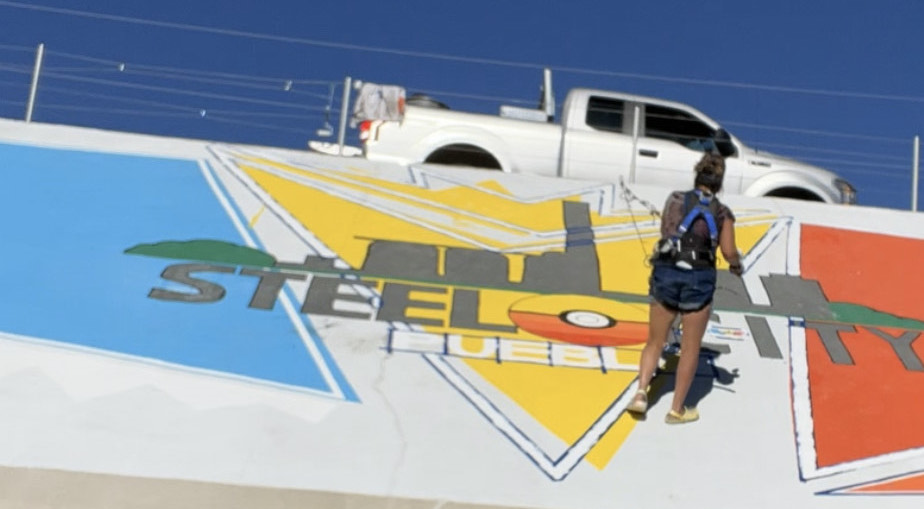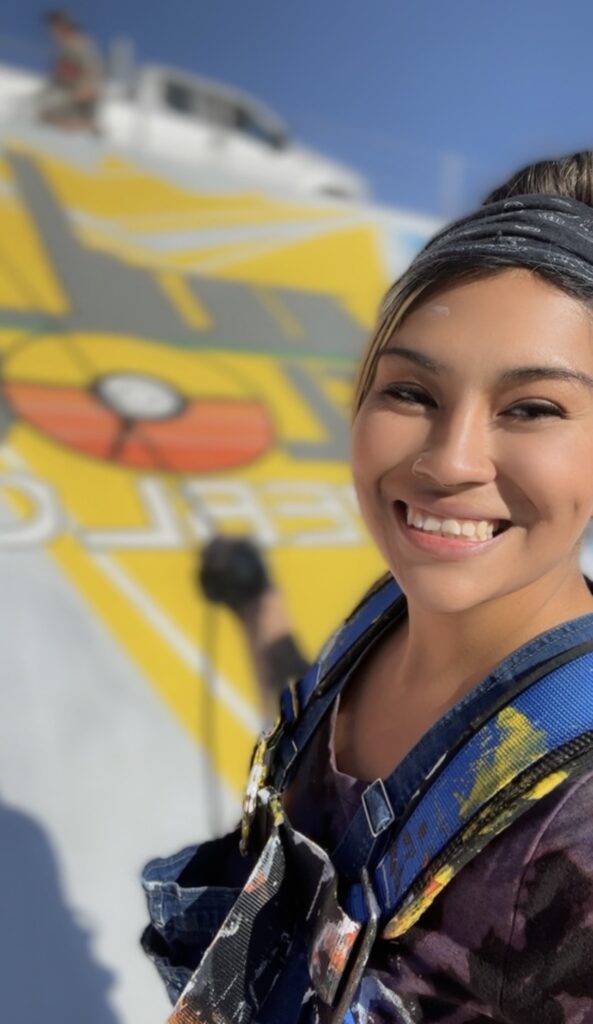You’ll have to get off the interstate if you want to see it, but Pueblo’s world-famous art wall levee is surely as eyecatching as the world’s biggest ball of string or the world’s biggest ketchup bottle. But what’s even better is that it’s only a matter of days before Pueblo’s own ‘world’s longest painting’ gets even more amazing!

The mural—all three miles of it—adorns the levee walls of that part of the Arkansas River that runs through Pueblo. So unique is this Gulliver-sized work of art that The Guinness Book of World Records lists Pueblo as the official home of the ‘world’s longest outdoor painting.’ As famous baseball manager and malaprop virtuoso Casey Stengel used to say, ‘You could look it up!’
Now, with warm weather and longer days, Pueblo artist Desiree Talmich is preparing to stamp her imprimatur onto this riverside shrine. Talmich won out over a number of artists in the city’s Levee Mural Project contest. She also won the $1,000 prize, the bulk of which will be invested in art supplies to finish the work.
Winning was nice and the money, too, said Talmich, but having her art as a part of this unique project is the real reward. “It takes a lot of confidence to put your art out there,” said the self-trained artist and digital creator. “Just knowing that you can do what you love, put a piece of art- work that means something to you is the most meaningful thing to me.”
When complete, said Talmich, the 24×48 foot mural will depict a snapshot of the city’s and region’s history, with a multi-colored ‘PUEBLO’ dominating the piece. The colors in the ‘P’ for Pueblo will symbolize the four directions. It will also pay homage to each of the Native American tribes-Arapahoe, Jicarilla Apache and Ute—whose roots once ran deep in this high desert region.
Following the ‘P’ for Pueblo will be a ‘UEB’ featuring the colors of the flags that now or once flew over Pueblo; the American, French, Mexican, Spanish and Texan banners. The ‘L’ and ‘O’ completing ‘Pueblo’ will feature the colors of Colorado’s state flag and the City of Pueblo’s flag, respectively. In all, Talmich’s mural will cover 220 years of the region’s history. There will also be images of Pueblo’s steel mill, its famous chile crop and, of course, Fort Pueblo, prominently placed on the flag.
The first dab of paint on the levee wall, Talmich anticipates, will land on the mural in a few weeks. But because she also holds down a full-time job as a caregiver, the 30-year-old artist doesn’t expect the final brush stroke to come before October. But everyday when she’s working to complete her mural, she says, will be a day where she’s doing exactly what she wants to do and being exactly where she wants to be. “I just like the peace,” Talmich said. “Being out there, painting, you just get in your zone. It’s such a nice environment with nice distractions. I really love it.”
On the other side of the levee walls is one of Pueblo’s architectural crown jewels, the majestic, red rock train sta- tion. It might be nice to look up and see it once in a while as she works on her art, but being next to the river, hearing the sounds it makes as it rushes by to feed a thirsty land and nurture the wildlife who depend on it, more than makes up for blocking the view. Her ‘studio’ for the next four months will also feature a bounty of wildlife that includes deer, waterfowl and various reptiles, “some I can’t identify,” she said with a chuckle.
While art and drawing have come naturally to her, Talmich has no formal training. Her interest in art has been, since early childhood, just came naturally. There was always a pencil, pen or paintbrush in her hand creating the images conjured up by an artist’s imagination. “I always said I wanted to be an artist,” said the Lamar native. So far the now full-time Puebloan has worked toward that goal.

Talmich would one day like to transition from part-time artist and creator to making it her full-time vocation. When that day arrives, she said, is anybody’s guess. For the present, she’s happy that she can fulfill her desire to create and share the colorful images conceived in her mind. But there is one reality that has already landed hard.
Besides paints and brushes, the basics for her project, she knows she’ll need a laundry list of other things, not the least of which are long sleeved clothing, sunscreen, and plenty of repellent to fend of the swarms of mosquitos that will be sharing the riverbanks with her for the rest of the summer. There will also be unanticipated costs. There always are.
In a phone interview, she said she hopes she can raise the remainder of the money she’ll need locally. A GoFundMe effort might be an option. But for now, the goodwill of her Pueblo artist community and anyone else who might want to make a small contribution is what she is hoping for. She guesses when the final drop of paint is splashed on the levee wall, she’ll have spent “approximately $5,000.”
To see Talmich’s homage to Pueblo, visitors can park anywhere near the city’s historic railroad station and walk across the Union Avenue bridge where they can peer down or take a walk down to the riverbanks and see ‘the world’s longest painting’ up close. The path is clearly marked.





